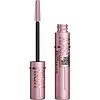What's inside
What's inside
 Key Ingredients
Key Ingredients

No key ingredients
 Benefits
Benefits

 Concerns
Concerns

 Ingredients Side-by-side
Ingredients Side-by-side

Water
Skin ConditioningPropylene Glycol
HumectantStyrene/Acrylates/Ammonium Methacrylate Copolymer
Polyurethane-35
Cera Alba
EmollientSynthetic Fluorphlogopite
Glyceryl Stearate
EmollientCetyl Alcohol
EmollientPEG-200 Glyceryl Stearate
Ethylenediamine/Stearyl Dimer Dilinoleate Copolymer
Skin ConditioningCopernicia Cerifera Cera
EmollientStearic Acid
CleansingPalmitic Acid
EmollientEthylene/Va Copolymer
Emulsion StabilisingAlcohol Denat.
AntimicrobialParaffin
PerfumingAminomethyl Propanediol
BufferingPhenoxyethanol
PreservativeCaprylyl Glycol
EmollientGlycerin
HumectantHydroxyethylcellulose
Emulsion StabilisingButylene Glycol
HumectantRayon
Xanthan Gum
EmulsifyingCaprylic/Capric Triglyceride
MaskingSodium Laureth Sulfate
CleansingDisodium EDTA
Myristic Acid
CleansingTetrasodium EDTA
Pentaerythrityl Tetra-Di-T-Butyl Hydroxyhydrocinnamate
AntioxidantPotassium Sorbate
PreservativeSilica
AbrasiveSoluble Collagen
HumectantBambusa Vulgaris Extract
Skin ConditioningTrisodium EDTA
CI 77491
Cosmetic ColorantCI 77492
Cosmetic ColorantCI 77499
Cosmetic ColorantCI 77007
Cosmetic ColorantMica
Cosmetic ColorantCI 77891
Cosmetic ColorantCI 75470
Cosmetic ColorantCI 77288
Cosmetic ColorantCI 77742
Cosmetic ColorantCI 77510
Cosmetic ColorantCeramide AP
Skin ConditioningWater, Propylene Glycol, Styrene/Acrylates/Ammonium Methacrylate Copolymer, Polyurethane-35, Cera Alba, Synthetic Fluorphlogopite, Glyceryl Stearate, Cetyl Alcohol, PEG-200 Glyceryl Stearate, Ethylenediamine/Stearyl Dimer Dilinoleate Copolymer, Copernicia Cerifera Cera, Stearic Acid, Palmitic Acid, Ethylene/Va Copolymer, Alcohol Denat., Paraffin, Aminomethyl Propanediol, Phenoxyethanol, Caprylyl Glycol, Glycerin, Hydroxyethylcellulose, Butylene Glycol, Rayon, Xanthan Gum, Caprylic/Capric Triglyceride, Sodium Laureth Sulfate, Disodium EDTA, Myristic Acid, Tetrasodium EDTA, Pentaerythrityl Tetra-Di-T-Butyl Hydroxyhydrocinnamate, Potassium Sorbate, Silica, Soluble Collagen, Bambusa Vulgaris Extract, Trisodium EDTA, CI 77491, CI 77492, CI 77499, CI 77007, Mica, CI 77891, CI 75470, CI 77288, CI 77742, CI 77510, Ceramide AP
Water
Skin ConditioningBeeswax
Emulsion StabilisingOzokerite
Emulsion StabilisingShellac
EmollientGlyceryl Stearate
EmollientTriethanolamine
BufferingPropylene Glycol
HumectantStearic Acid
CleansingSorbitan Sesquioleate
EmulsifyingMethylparaben
PreservativeQuaternium-15
PreservativeQuaternium-22
Simethicone
EmollientButylparaben
MaskingIron Oxides
CI 77891
Cosmetic ColorantCI 77007
Cosmetic ColorantMica
Cosmetic Colorant
 Reviews
Reviews

Ingredients Explained
These ingredients are found in both products.
Ingredients higher up in an ingredient list are typically present in a larger amount.
This pigment is called Ultramarine blue lazurite. It gives a saturated blue color, but can be used to create other colors as well.
According to the manufacturer, it is usually made from kaolin, sodium sulfate, sodium carbonate, sulfur, and charcoal.
Ci 77891 is a white pigment from Titanium dioxide. It is naturally found in minerals such as rutile and ilmenite.
It's main function is to add a white color to cosmetics. It can also be mixed with other colors to create different shades.
Ci 77891 is commonly found in sunscreens due to its ability to block UV rays.
Learn more about CI 77891Glyceryl Stearate is a mix of glycerin and stearic acid.
It is used to stabilize the mixing of water and oil ingredients. By preventing these ingredients from separating, it can help elongate shelf life. It can also help thicken the product's texture.
As an emollient, it helps soften skin and supports barrier-replenishing ingredients.
In cosmetics, Glyceryl Stearate is often made from vegetable oils or synthetically produced.
This ingredient may not be fungal-acne safe
Fun fact: The human body also creates Glyceryl Stearate naturally.
Learn more about Glyceryl StearateMica is a naturally occurring mineral used to add shimmer and color in cosmetics. It can also help improve the texture of a product or give it an opaque, white/silver color.
Serecite is the name for very fine but ragged grains of mica.
This ingredient is often coated with metal oxides like titanium dioxide. Trace amounts of heavy metals may be found in mica, but these metals are not harmful in our personal products.
Mica has been used since prehistoric times throughout the world. Ancient Egyptian, Indian, Greek, Roman, Aztec, and Chinese civilizations have used mica.
Learn more about MicaPropylene Glycol is an odorless, colorless liquid. As a humectant, it helps skin retain moisture. It also aids in delivering active ingredients.
Another role of this ingredient is preventing a product from melting or freezing. Propylene glycol also adds antimicrobrial properties to a product, elongating product lifespan.
This ingredient is considered an organic alcohol and commonly added into both cosmetics and foods.
Those with sensitive skin or conditions may develop a rash when using this ingredient.
Learn more about Propylene GlycolStearic Acid is a fatty acid. It is an emollient, emulsifier, and texture enhancer.
As an emollient, stearic acid helps soften skin. It aids the skin's protective barrier by preventing water loss. It also provides a gentle cleansing effect without stripping away natural oils.
Stearic acid may also be used to enhance the texture of products. It can add volume and stabilize ingredients such as water and oil. This can help water and oil ingredients from separating.
Sources of stearic acid include animal or vegetable fats/oils such as coconut or shea. It can be naturally found in butter, cocoa butter, shea butter, vegetable fats, and animal tallow.
This ingredient may not be Malassezia folliculitis, or fungal-acne safe.
Learn more about Stearic AcidWater. It's the most common cosmetic ingredient of all. You'll usually see it at the top of ingredient lists, meaning that it makes up the largest part of the product.
So why is it so popular? Water most often acts as a solvent - this means that it helps dissolve other ingredients into the formulation.
You'll also recognize water as that liquid we all need to stay alive. If you see this, drink a glass of water. Stay hydrated!
Learn more about Water